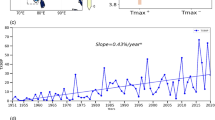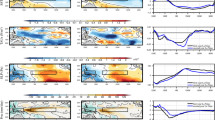Abstract
The Eurasian (EU) pattern was shown to be closely linked to the North Atlantic sea surface temperature (SST) in boreal winter, and this study suggest that such linkage varies with time and that the structure of the EU pattern also changes accordingly. During the period with strong EU-SST linkage (1961–1977 and 1993–2013, denoted as HIGH epoch), the EU pattern is a well-defined barotropic wave train stretching from the North Atlantic towards East Asia-western North Pacific, and it facilitates cooling and slight reduction of precipitation over East Asia and enhanced precipitation over Europe in its positive phase. During the period with weak EU-SST linkage (1948–1960 and 1978–1992, denoted as LOW epoch), in contrast, its centre over Northern Europe weakens sharply, and the wave-like structure of the EU pattern is not well established. In this case, its influences on precipitation over Europe almost vanish, but its influences on both the surface air temperature and precipitation over East Asia amplify significantly. The Atlantic centre of the EU pattern forms from different mechanism during the two epochs. It can be excited by the underlying North Atlantic SST via eddy-mediated processes during the HIGH epoch, while it is likely generated by an incoming Rossby wave train from upstream region during the LOW epoch. Nevertheless, its location and intensity remain similar during the two epochs. Numerical experiments with a barotropic model suggest that the contrasting structure of the EU pattern is mainly attributed to the changes of the atmospheric mean flow.














Similar content being viewed by others
References
Barnston AG, Livezey RE (1987) Classification, seasonality and persistence of low-frequency atmospheric circulation patterns. Mon Weather Rev 115:1083–1126
Bretherton CS, Widmann M, Dymnikov VP, Wallace JM, Blade I (1999) The effective number of spatial degrees of freedom of a time-varying field. J Clim 12:1990–2009
Chen MY, Xie PP, Janowiak JE, Arkin PA (2002) Global land precipitation: a 50-yr monthly analysis based on gauge observations. J Hydrometeorol 3:249–266
Chen SF, Wu RG, Chen W (2015a) The changing relationship between interannual variations of the North Atlantic Oscillation and northern tropical Atlantic SST. J Clim 28:485–504
Chen SF, Chen W, Wu RG (2015b) An Interdecadal change in the relationship between boreal spring Arctic Oscillation and the East Asian summer monsoon around the early 1970s. J Clim 28:1527–1542
Chen SF, Wu RG (2017) Interdecadal changes in the relationship between interannual variations of spring north Atlantic SST and Eurasian surface air temperature. J Clim 30:3771–3787
Chen W, Graf HF, Huang RH (2000) The interannual variability of East Asian winter monsoon and its relation to the summer monsoon. Adv Atmos Sci 17:48–60
Frankignoul C (1985) Sea-surface temperature anomalies, planetary-waves, and air-sea feedback in the middle latitudes. Rev Geophys 23:357–390
Gambo K, Lu L, Li WJ (1987) Numerical simulation of Eurasian teleconnection pattern in atmospheric circulation during the Northern Hemisphere winter. Adv Atmos Sci 4:385–394
Hong XW, Lu RY (2016) The meridional displacement of the summer Asian jet, Silk Road pattern, and tropical SST anomalies. J Clim 29:3753–3766
Hoskins BJ, Karoly DJ (1981) The steady linear response of a spherical atmosphere to thermal and orographic forcing. J Atmos Sci 38:1179–1196
Hu CD, Yang S, Wu QG (2015) An optimal index for measuring the effect of East Asian winter monsoon on China winter temperature. Clim Dyn 45:2571–2589. https://doi.org/10.1007/s00382-015-2493-5
Kalnay E, Kanamitsu M, Kistler R, Collins W et al (1996) The NCEP/NCAR 40-year reanalysis project. Bull Am Meteorol Soc 77:437–471
Kaspi Y, Schneider T (2013) The role of stationary eddies in shaping midlatitude storm tracks. J Atmos Sci 70:2596–2613. https://doi.org/10.1175/JAS-D-12-082.1
Kobayashi S, Ota Y, Harada H, Ebita A et al (2015) The JRA-55 reanalysis: general specifications and basic characteristics. J Meteorol Soc Japan 93:5–48. https://doi.org/10.2151/jmsj.2015-001
Kug JS, Jin FF (2009) Left-hand rule for synoptic eddy feedback on low-frequency flow. Geophys Res Lett 36:L05709. https://doi.org/10.1029/2008GL036435
Kushnir Y, Robinson WA, Blade I, Hall NMJ, Peng S, Sutton R (2002) Atmospheric GCM response to extratropical SST anomalies: synthesis and evaluation. J Clim 15:2233–2256
Lau NC, Holopainen EO (1984) Transient eddy forcing of the time-mean flow as identified by geopotential tendencies. J Atmos Sci 41:313–328
Lau NC, Nath M (1991) Variability of the baroclinic and barotropic transient eddy forcing associated with monthly changes in the mid-latitude storm tracks. J Atmos Sci 48:2589–2613
Li SL (2004) Impact of northwest Atlantic SST anomalies on the circulation over the Ural Mountains during early winter. J Meteorol Soc Japan Ser II 82:971–988
Lim YK, Kim HD (2016) Comparison of the impact of the Arctic Oscillation and Eurasian teleconnection on interannual variation in East Asian winter temperatures and monsoon. Theor Appl Climatol 124:267–279
Liu YY, Wang L, Zhou W, Chen W (2014) Three Eurasian teleconnection patterns: spatial structures, temporal variability, and associated winter climate anomalies. Clim Dyn 42:2817–2839. https://doi.org/10.1007/s00382-014-2163-z
Ma XH, Chang P, Saravanan R, Wu DX, Lin XP, Wu LX, Wan XQ (2015a) Winter extreme flux events in the Kuroshio and Gulf Stream extension regions and relationship with modes of North Pacific and Atlantic variability. J Clim 28:4950–4970. https://doi.org/10.1175/JCLI-D-14-00642.1
Ma XH, Chang P, Saravanan R, Montuoro R, Hsieh JS, Wu DX, Lin XP, Wu LX, Jing Z (2015b) Distant influence of Kuroshio eddies on North Pacific weather patterns? Sci Rep 5:17785. https://doi.org/10.1038/srep17785
Nakamura H, Tanaka M, Wallace JM (1987) Horizontal structure and energetics of northern hemisphere wintertime teleconnection patterns. J Atmos Sci 44:3377–3391
Nie Y, Zhang Y, Chen G, Yang XQ (2016) Delineating the barotropic and baroclinic mechanisms in the midlatitude eddy-driven jet response to lower-tropospheric thermal forcing. J Atmos Sci 73:429–448. https://doi.org/10.1175/JAS-D-15-0090.1
O’Reilly CH, Czaja A (2014) The response of the Pacific storm track and atmospheric circulation to Kuroshio extension variability. Q J R Meteorol Soc 141:52–66. https://doi.org/10.1002/qj.2334
Ogawa F, Nakamura H, Nishii K, Miyasaka T, Yoshida A (2016) Importance of midlatitude oceanic frontal zones for the Annular Mode variability: interbasin differences in the Southern Annular Mode signature. J Clim 29:6179–6199. https://doi.org/10.1175/JCLI-D-15-0885.1
Peng SL, Whitaker JS (1999) Mechanisms determining the atmospheric response to mid-latitude SST anomalies. J Clim 12:1393–1408
Qiao SB, Feng GL (2016) Impact of the December North Atlantic Oscillation on the following February East Asian trough. J Geophys Res 121:10074–10088. https://doi.org/10.1002/2016JD025007
Rayner NA, Parker DE, Horton EB, Folland CK, Alexander LV, Rowell DP, Kent EC, Kaplan A (2003) Global analyses of sea surface temperature, sea ice, and night marine air temperature since the late nineteenth century. J Geophys Res 108:4407. https://doi.org/10.1029/2002JD002670
Sardeshmukh PD, Hoskins BJ (1988) The generation of global rotational flow by steady idealized tropical divergence. J Atmos Sci 45:1228–1251
Song L, Wang L, Chen W, Zhang Y (2016) Intraseasonal variation of the strength of the East Asian trough and its climatic impacts in boreal winter. J Clim 29:2557–2577. https://doi.org/10.1175/JCLI-D-14-00834.1
Sung MK, Lim GH, Kwon WT, Boo KO, Kug JS (2009) Short-term variation of Eurasian pattern and its relation to winter weather over East Asia. Int J Climatol 29:771–775
Tachibana Y, Nakamura T, Tazou N (2007) Interannual variation in snow-accumulation events in Tokyo and its relationship to the Eurasian pattern. Sci Online Lett Atmos 3:129–131
Takaya K, Nakamura H (2001) A Formulation of a phase-independent wave-activity flux for stationary and migratory quasigeostrophic eddies on a zonally varying basic flow. J Atmos Sci 58:608–627
Takaya K, Nakamura H (2013) Interannual variability of the East Asian winter monsoon and related modulations of the planetary waves. J Clim 26:9445–9461
Vallis GK, Gerber EP, Kushner PJ, Cash BA (2004) A mechanism and simple dynamical model of the North Atlantic Oscillation and annular modes. J Atmos Sci 61:264–280
Wallace JM, Gutzler DS (1981) Teleconnections in the geopotential height field during the Northern Hemisphere winter. Mon Weather Rev 109:784–812
Wang L, Chen W (2010) How well do existing indices measure the strength of the East Asian winter monsoon? Adv Atmos Sci 27:855–870. https://doi.org/10.1007/s00376-009-9094-3
Wang L, Chen W (2014a) The East Asian winter monsoon: re-amplification in the mid-2000s. Chinese Sci Bull 59:430–436. https://doi.org/10.1007/s11434-013-0029-0
Wang L, Chen W (2014b) An intensity index for the East Asian winter monsoon. J Clim 27:2361–2374. https://doi.org/10.1175/JCLI-D-13-00086.1
Wang L, Lu MM (2017) The East Asian winter monsoon. In: Chang CP, Kuo HC, Lau NC, Johnson RH, Wang B, Wheeler M (eds) The global monsoon system: research and forecast, 3rd edn. World Scientific Publishing Company, Singapore, pp 51–61. https://doi.org/10.1142/9789813200913_0005 (Chap. 5)
Wang L, Chen W, Huang RH (2008) Interdecadal modulation of PDO on the impact of ENSO on the East Asian winter monsoon. Geophys Res Lett 35:L20702. https://doi.org/10.1029/2008GL035287
Wang N, Zhang Y (2015) Evolution of Eurasian teleconnection pattern and its relationship to climate anomalies in China. Clim Dyn 44:1017–1028
Willmott CJ, Matsuura K (2001) Terrestrial air temperature and precipitation: monthly and annual time series (1950–1999). https://www.esrl.noaa.gov/psd/data/gridded/data.UDel_AirT_Precip.html
Wu HB (1993) Relationships between winter temperature anomalies in China and 500-hPa teleconnection patterns of the atmospheric circulation in the Northern Hemisphere. J Nanjing Inst Meteorol (in Chinese) 16:115–119
Xiao B, Zhang Y, Yang XQ, Nie Y (2016) On the role of extratropical air-sea interaction in the persistence of the Southern Annular Mode. Geophy Res Lett 43:8806–8814. https://doi.org/10.1002/2016GL070255
Yang GY, Hoskins BJ (1996) Propagation of Rossby waves of nonzero frequency. J Atmos Sci 53:2365–2378
Acknowledgements
We thank the three anonymous reviewers for their insightful comments and constructive suggestions that led to significant improvement of the manuscript. We also thank Drs. Wei Chen, Kaiming Hu, Xiaowei Hong of IAP, Dr. Jie Zhang of NCC, and Dr. Wen Chen of UMD for helpful discussions. This work was supported jointly by the Key Research Program of Frontier Sciences of Chinese Academy of Sciences (QYZDY-SSW-DQC024), the National Natural Science Foundation of China (41405053, 41721004, 41605050), the Fundamental Research Funds for the Central Universities, and Open Research Fund Program of Plateau Atmosphere and Environment Key Laboratory of Sichuan Province (PAEKL-2016-C7).
Author information
Authors and Affiliations
Corresponding author
Rights and permissions
About this article
Cite this article
Wang, L., Liu, Y., Zhang, Y. et al. Time-varying structure of the wintertime Eurasian pattern: role of the North Atlantic sea surface temperature and atmospheric mean flow. Clim Dyn 52, 2467–2479 (2019). https://doi.org/10.1007/s00382-018-4261-9
Received:
Accepted:
Published:
Issue Date:
DOI: https://doi.org/10.1007/s00382-018-4261-9




